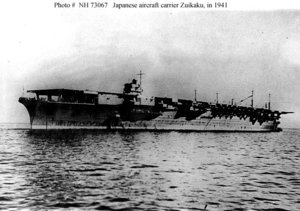Japanese aircraft carrier Zuikaku
|
|

| |
| Career | 
|
|---|---|
| Ordered: | |
| Laid down: | 25 May 1938 |
| Launched: | 27 November 1939 |
| Commissioned: | 25 September 1941 |
| Fate: | Sunk by air attack in the battle of Cape Engaño on 25 October 1944 |
| Struck: | 26 August 1945 |
| General Characteristics | |
| Displacement: | 29,800 tons |
| Length: | 257.5 m |
| Beam: | 26 m |
| Draught: | 8.9 m |
| Propulsion: | Kanpon geared turbines, 8 boilers, 4 shafts, 160,000 hp (119 MW) |
| Speed: | 34.5 knots (63.9 km/h) |
| Range: | 9,700 nautical miles (18000 km) at 18 knots (33 km/h) |
| Complement: | 1,660 |
| Armament: | 16 x 5 in (127 mm) guns 42 x 25 mm anti-aircraft guns |
| Aircraft: | 84 |
Zuikaku (Japanese: 瑞鶴, meaning "fortunate crane") was a Shokaku-class aircraft carrier of the Imperial Japanese Navy. Her planes took part in the attack on Pearl Harbor that started the Pacific War, and she fought in several of the most important naval battles of the war, finally being sunk in the battle off Cape Engaño.
In 1941 Zuikaku, under the command of Captain Yokokawa Ichibei, and her sister ship Shokaku made up Carrier Division 5. On 26 November 1941 she left Hittokapu Bay for the attack on Pearl Harbor. On 7 December 1941 she launched two waves of planes against the United States Navy base at Pearl Harbor. In the first wave, 25 Vals attacked the airbase at Wheeler Field and 5 Zeros attacked the airbase at Kaneohe. In the second wave, 27 Kates attacked the airbase at Hickam Field and 17 Vals targeted California and Maryland.
Her planes attacked Rabaul on 20 January 1942 and Lae in New Guinea on 21 January. In April 1942 she took part in the Indian Ocean raid, striking the British naval bases at Colombo and Trincomalee on Ceylon.
In May 1942 she was assigned along with Shokaku and Shoho to cover Operation MO, the invasion of Port Moresby, New Guinea. Alerted by signal decrypts, the Allies were able to dispatch the carriers Yorktown and Lexington against the Japanese. On 8 May 1942, the main carrier forces located one another and launched maximum effort raids, which passed each other in the air. Hidden by a rain squall, Zuikaku escaped detection, but Shokaku was hit three times by bombs and was unable to launch or land her planes. Zuikaku was undamaged but had lost half her planes in the battle and had to return to Japan for resupply. Thus neither carrier was able to take part in the battle of Midway in June, when their presence might have decided the battle. For more details, see Battle of the Coral Sea.
In August 1942, commanded by Captain Tameteru Notomo, Zuikaku and the rest of Carrier Division 1 was dispatched to the Solomon Islands to drive away the US fleet. On 24 August 1942, in the battle of the Eastern Solomons her planes attacked and severely damaged Enterprise.
On 26 October 1942 in the battle of the Santa Cruz Islands, her planes again damaged Enterprise, and crippled Hornet (she was abandoned and later sunk by the Japanese destroyers Akigumo and Makigumo). However, Shokaku and Zuiho were both severely damaged by American air attack, and Zuikaku had to pick up the surviving planes. Of the 110 planes launched by the Japanese carriers, only 44 returned to Zuikaku.
Oyoda_alongside_Zuikaku.jpg
In February 1943 she covered the evacuation of Guadalcanal. In May 1943 she was assigned to a mission to repulse the Allies from Attu in the Aleutian Islands, but after the Allied victory on May 29 1943 the operation was cancelled. Later in 1943, under the command of Captain Kikuchi Tomozo, she was based at Truk and operated against US forces in the Marshall Islands.
In 1944 she was based at Singapore. In June 1944 she was assigned to Operation A-Go, an attempt to repulse the Allied invasion of the Mariana Islands. On 19 June 1944, in the battle of the Philippine Sea, Taiho and Shokaku were both sunk by submarine attack, leaving Zuikaku, the only surviving carrier of Carrier Division 1, to recover their few surviving planes. On 20 June a bomb hit started a fire in the hangar, but Zuikaku's experienced damage control teams were able to get it under control, and she was able to escape under her own power.
After the battle, Zuikaku was the only remaining survivor of the six fleet carriers that had launched the attack on Pearl Harbor.
Lowering_the_flag_on_Zuikaku.jpg
In October 1944 she was the flagship of Admiral Jisaburo Ozawa's decoy Northern Force in Operation Shō-1. On 24 October 1944 she took part in the battle off Cape Engaño. She launched her remaining aircraft in an ineffective strike against the US Third Fleet: most were shot down by the American covering patrols, but a few survivors made it safely to Luzon. Then she came under heavy air attack and was hit by seven torpedoes and nine bombs. With Zuikaku listing heavily to port, Ozawa transferred his flag to Oyodo. The order to abandon ship was issued at 13:58 and the flag was lowered. Zuikaku rolled over and sank at 14:14, taking Captain Kaizuka Takeo and 842 men down with her. 862 men were rescued by Wakatsuki and Kuwa.
See also
External links
- Tabular record of movement (http://www.combinedfleet.com/Zuikak.htm) from combinedfleet.com (http://www.combinedfleet.com/)de:HIJMS Zuikaku
